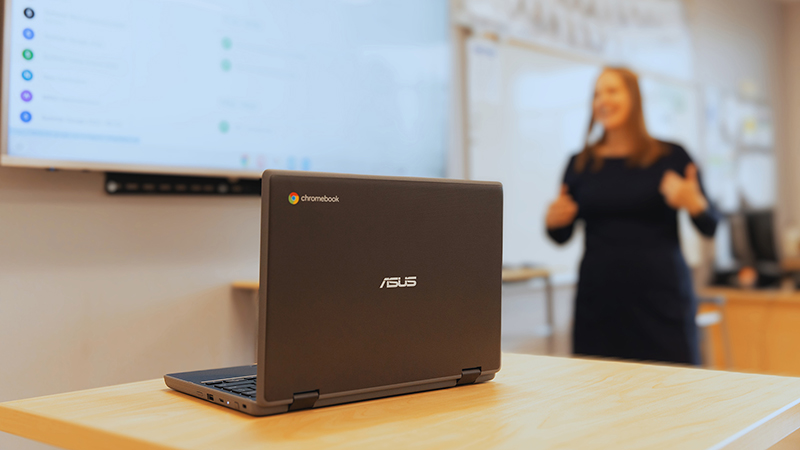
Chromebooks for the Classroom: How Wild Rose School Division Made the Right Choice with ASUS

In Alberta's Wild Rose School Division (WRSD), technology isn't just a tool, it's the foundation of modern education. With 16 schools spread across six unique communities, WRSD serves close to 5,000 students, from small, rural K-12 schools to larger institutions like West Central High School. Faced with the challenge of preparing students for an increasingly digital world, WRSD set out to equip nearly every student with a Chromebook. The journey to this achievement was complex, but WRSD found a dependable partner in ASUS Chromebooks. Combining the security and simplicity of ChromeOS with the durability and longevity of ASUS devices, WRSD successfully built a robust, future-ready technology fleet that meets the diverse needs of its students, making it one of Alberta’s most advanced school divisions.
While doing so, WRSD faced significant challenges in its move to tech-enabled education, including varying school sizes and budget constraints. "Our schools range from 100 to over 500 students," says IT Director Jaymon Lefebvre, highlighting the need for a scalable and adaptable solution. As a publicly funded institution, WRSD required devices that could withstand daily student use while offering long-term functionality and upgradability, all within a tight budget.

Why Chromebooks, and why ASUS Chromebooks?
Faced with these challenges, WRSD embarked on a thorough evaluation of available technology options. Led by Jaymon Lefebvre, the IT team sought a solution that balanced affordability, performance, durability, security, manageability, and ease of use.
ASUS Chromebooks quickly emerged as the ideal choice. "ASUS Chromebooks offered us the perfect blend of affordability and durability," Lefebvre says. Their robust construction handled the wear and tear of daily student use, while competitive pricing allowed WRSD to maximize its budget with models like the ASUS Chromebook C202 and C204.
The success of WRSD’s adoption of ASUS Chromebooks is rooted in the exceptional performance of earlier models like the ASUS Chromebook Flip C302. "Our experience with the first generation of ASUS Chromebooks was so positive that many teachers were reluctant to let them go, even after Google’s AUP had expired," recalls Jaymon. "The impressive longevity of these devices played a key role in continuing our partnership with ASUS." He continues, "We’ve had great success with battery life on ASUS devices. Even on the older Chromebook Flip C302 models, the batteries held strong, even during power-intensive tasks like casting. Other vendors have struggled, but ASUS consistently delivers long-lasting performance."
Ease of use was another critical factor in the decision. ASUS Chromebooks’ seamless integration with Google Workspace for Education made them a natural fit for WRSD’s digital infrastructure. "The simplicity of the Chromebooks reduced the learning curve for both students and teachers," Lefebvre shares, a crucial consideration given the division's limited IT resources.
Reflecting on the transition to ASUS Chromebooks, IT Director Jaymon Lefebvre recalls, "Before adopting Chromebooks, our seven IT staff managed 1,600 devices. Now, with Wi-Fi and Chrome OS, we're closer to 6,000 devices without needing more staff." This shift underscores the efficiency and ease of management that Chrome OS provides, significantly streamlining device maintenance.
Overcoming Cybersecurity Challenges with ASUS Chromebooks
Adopting technology in schools is a complex task, especially with the added layer of cybersecurity concerns. For the Wild Rose School Division, ASUS Chromebooks became the clear choice, balancing security needs with budget constraints.
Jaymon Lefebvre, IT Director, explains, "With other systems, cybersecurity requirements can add up to $300 annually per device, on top of the initial cost." This made the secure and cost-effective ChromeOS an obvious choice. "The simplicity and ease of management of Chrome OS are awesome. Having security built into Chrome OS without additional costs significantly reduces the total cost of ownership."
By choosing ASUS Chromebooks, WRSD avoided escalating cybersecurity expenses, efficiently utilizing their technology budget while setting an example for other school divisions facing similar challenges.

Navigating Implementation Challenges with ASUS Chromebooks and the latest tech
When the WRSD modernized its classrooms, they faced implementation challenges, including technical issues and concerns from parents and teachers. Balancing traditional learning with new technology was key. "Early adopters were eager to use technology for everything, but we had to find balance," recalls Jen Lefebvre, Director of Instruction. "Technology couldn’t replace foundational skills; it had to augment them." A pivotal moment was the introduction of ASUS models with USI stylus support, which “opened up new possibilities in visual learning, particularly in math," noted Jen.
From an IT perspective, ensuring robust Wi-Fi capable of supporting a growing number of devices was a major challenge. "A challenge for us from an IT perspective has been providing robust Wi-Fi that can keep up with the number of devices," says Jaymon. "Wi-Fi 6e and Wi-Fi 7 actually start to solve these problems. But along with that, we also need a vendor that's interested in putting in the wireless antennas into the devices. That's been a really positive relationship with ASUS, they're focused on futureproofing with Wi-Fi 6e, and now 7 is coming."
WRSD’s collaboration with ASUS also extended to product development, with teachers offering feedback on early models. "Testing new ASUS devices and providing feedback was valuable," adds Jen. "It helped us influence the development of tools tailored to our educational needs."
ASUS’s continuous drive for innovation played a critical role in WRSD’s early adoption of USB-C technology. "ASUS was one of the first vendors to move everything to USB-C, and it changed our lives," said Jaymon. "Now, when devices go to the end of life, we can actually take the chargers back and repurpose them," he adds. This not only reduced the cost for replacement chargers but also improved operational efficiency and sustainability in the high-density device environment.

A Blueprint for Success
By carefully choosing a cost-effective, durable, and easy-to-use solution, WRSD has created a modern learning environment that's ready for the digital age. This move not only tackled their immediate logistical and budget challenges but also set an example for other schools looking to upgrade their solution. This is why multiple school visit WRSD every year to take example and study their solutions and implementation strategy. As WRSD continues to benefit from ASUS Chromebooks, their experience offers valuable lessons for schools making similar tech changes. WRSD’s story highlights how smart tech investments can really boost the educational experience and set new benchmarks for digital learning.
SUS is dedicated to enhancing education with cutting-edge, dependable, and cost-effective technology that adapts to the ever-changing needs of students and educators.
Discover how ASUS Chromebooks have made a difference in Wild Rose School Division through the insights of WRSD's Director of Instruction, Jen Lefbvre. Explore the full case study here: Case Study: Wild Rose School Division's Digital Transformation with ASUS Chromebooks
